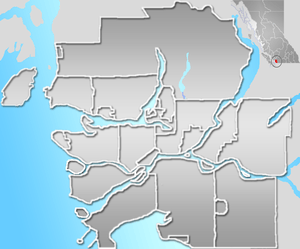Ironworkers Memorial Second Narrows Crossing
| Ironworkers Memorial Bridge | |
|---|---|
 | |
| Coordinates | 49°17′43″N 123°01′35″W / 49.295296°N 123.026276°WCoordinates: 49°17′43″N 123°01′35″W / 49.295296°N 123.026276°W |
| Carries | Six lanes of British Columbia Highway 1, pedestrians and bicycles |
| Crosses | Burrard Inlet |
| Locale |
Vancouver District of North Vancouver |
| Official name | Ironworkers Memorial Second Narrows Crossing |
| Maintained by | British Columbia Ministry of Transportation |
| Characteristics | |
| Design | truss/cantilever bridge |
| Material | steel |
| Total length | 1,292 metres (4,239 ft)[1] |
| Longest span | 335 metres (1,099 ft)[1] |
| History | |
| Designer | Swan, Wooster and Partners |
| Construction begin | 1957 |
| Opened | August 25, 1960 |
The Ironworkers Memorial Second Narrows Crossing, also called the Ironworkers Memorial Bridge and Second Narrows Bridge, is the second bridge constructed at the Second (east) Narrows of Burrard Inlet in Vancouver, British Columbia, Canada. Originally named the Second Narrows Bridge, it connects Vancouver to the north shore of Burrard Inlet, which includes the District of North Vancouver, the City of North Vancouver, and West Vancouver. It was constructed adjacent to the older Second Narrows Bridge, which is now exclusively a rail bridge. The First Narrows Bridge, better known as Lions Gate Bridge, crosses Burrard Inlet about 8 kilometres west of the Second Narrows.
The bridge is a steel truss cantilever bridge, designed by Swan Wooster Engineering Co. Ltd. Construction began in November 1957, and the bridge was officially opened on August 25, 1960. It cost approximately $15 million to build. Tolls were charged until 1963.
The bridge is 1,292 metres (4,239 ft) long with a centre span of 335 metres (1,099 ft). It is part of the Trans-Canada Highway (Highway 1).
In June of 2014 work began to widen the sidewalks on both sides of the bridge. That work included the addition of 'safety railings'. The 'railing' is composed of closely spaced vertical steel bars approximately ten feet high. The visual effect is a corridor-like narrowing of the bridge. There is a loss of direct light, and a complete loss of the views on both sides of the bridge.
Collapse
.jpg)
On June 17, 1958, as a crane stretched from the north side of the new bridge to join the two chords of the unfinished arch, several spans collapsed. Seventy-nine workers plunged 30 metres (100 ft) into the water. Eighteen were killed either instantly or shortly thereafter, possibly drowned by their heavy tool belts. A diver searching for bodies drowned later, bringing the total fatalities for the collapse to 19. In a subsequent Royal Commission inquiry, the bridge collapse was attributed to miscalculation by bridge engineers. A temporary arm, holding the fifth anchor span, was deemed too light to bear the weight.[2]
Renaming
The bridge was renamed the Ironworkers Memorial Second Narrows Crossing in 1994 to honour the 19 workers who died in the collapse, along with four others who also died during the construction process.[3]
In popular culture
Stompin' Tom Connors paid a musical tribute to the fallen ironworkers with the song "The Bridge Came Tumbling Down" on his 1972 album My Stompin' Grounds. (This tune also appears on several later compilations one of which was performed by Les Claypool's Duo de Twang). Jimmy Dean's 1962 song "Steel Men" is a ballad about the Second Narrows bridge disaster. Gary Geddes' 2007 book of poetry, entitled Falsework, is based on the collapse of the bridge.
Notes
- On February 2, 2009 several University of British Columbia engineering students were arrested while attempting to suspend the shell of a Volkswagen Beetle under the bridge as part of an "Engineering Week" tradition.
See also

References
- 1 2 Ironworkers Memorial Second Narrows Crossing at Structurae
- ↑ Lowe, Keith (2000-06-26). "Bridge disaster recalled". North Shore News. Archived from the original on 2005-12-15. Retrieved 2006-02-04.
- ↑ "50th anniversary of Second Narrows Bridge collapse". WorkSafe BC. 2008-06-17. Retrieved 2009-05-25.
External links
| Wikimedia Commons has media related to Ironworkers Memorial Second Narrows Crossing. |
- History of Metropolitan Vancouver
- Satellite image of the Ironworkers Memorial Bridge and Second Narrows Bridge
- Vancouver, BC Bridge Under Construction Collapses, June 1958 at GenDisasters.com